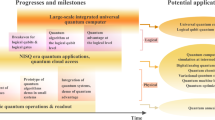Abstract
The construction of a perfectly secure private quantum channel in dimension d is known to require 2 log d shared random key bits between the sender and receiver. We show that if only near-perfect security is required, the size of the key can be reduced by a factor of two. More specifically, we show that there exists a set of roughly d log d unitary operators whose average effect on every input pure state is almost perfectly randomizing, as compared to the d2 operators required to randomize perfectly. Aside from the private quantum channel, variations of this construction can be applied to many other tasks in quantum information processing. We show, for instance, that it can be used to construct LOCC data hiding schemes for bits and qubits that are much more efficient than any others known, allowing roughly log d qubits to be hidden in 2 log d qubits. The method can also be used to exhibit the existence of quantum states with locked classical correlations, an arbitrarily large amplification of the correlation being accomplished by sending a negligibly small classical key. Our construction also provides the basic building block for a method of remotely preparing arbitrary d-dimensional pure quantum states using approximately log d bits of communication and log d ebits of entanglement.
Similar content being viewed by others
References
Braunstein, S., Lo, H.-K., Spiller, T.: Forgetting qubits is hot to do. Unpublished manuscript, 1999
Boykin, P. O., Roychowdhury, V.: Optimal encryption of quantum bits. http://arxiv.org/abs/quant-ph/0003059, 2000
Ambainis, A., Mosca, M., Tapp, A., de Wolf, R.: Private quantum channels. In IEEE Symposium on Foundations of Computer Science (FOCS), 2000, pp. 547–553
Bennett, C. H., Wiesner, S.: Communication via one- and two-particle operators on Einstein-Podolsky-Rosen states. Phys. Rev. Lett. 69(20), 2881–2884 (1992)
Eggeling, T., Werner, R. F.: Hiding classical data in multi-partite quantum states. Phys. Rev. Lett. 89(9), 097905 (2002)
DiVincenzo, D. P., Hayden, P., Terhal, B. M.: Hiding quantum data. Found. Phys. 33(11), 1629–1647 (2003)
DiVincenzo, D.P., Leung, D. W., Terhal, B. M.: Quantum data hiding. IEEE Trans. Inf. Theory 48(3), 580–598 (2002)
DiVincenzo, D. P., Horodecki, M., Leung, D., Smolin, J., Terhal, B. M.: Locking classical correlation in quantum states. Phys. Rev. Lett. 92, 067902 (2004)
Bennett, C. H., Hayden, P., Leung, D., Shor, P. W., Winter, A.: Remote preparation of quantum states. http://arxiv.org/abs/quant-ph/0307100, 2003
Bennett, C. H., Brassard, G., Crépeau, C., Jozsa, R., Peres, A., Wootters, W. K.: Teleporting an unknown quantum state via dual classical and Einstein-Podolsky-Rosen channels. Phys. Rev. Lett. 70, 1895–1899 (1993)
Lo, H.-K.: Classical-communication cost in distributed quantum-information processing: A generalization of quantum-communication complexity. Phys. Rev. A 62, 012313 (2000)
Leung, D.: Quantum vernam cipher. Quantum Info. Comp. 2, 14–34 (2001)
Leung, D., Shor, P.: Oblivious remote state preparation. Phys. Rev. Lett. 90, 127905 (2003)
Holevo, A. S.: Statistical problems in quantum physics. In: G. Maruyama J. V. Prokhorov, editors, Proceedings of the second Japan-USSR Symposium on Probability Theory, Volume 330 of Lecture Notes in Mathematics, Berlin: Springer-Verlag, 1973, pp. 104–119
Dembo, A., Zeitouni, O.: Large deviations techniques and applications. New York: Springer-Verlag, 1993
Zyczkowski, K., Sommers, H.-J.: Truncations of random unitary matrices. J. Phys. A 33, 2045–2057 (2000)
Bennett, C. H., DiVincenzo, D. P., Fuchs, C. A., Mor, T., Rains, E., Shor, P. W., Smolin, J. A., Wootters, W. K.: Quantum nonlocality without entanglement. Phys. Rev. A 59(2), 1070–1091 (1999)
Hayden, P.: Spin-cycle entanglement. In preparation
Verstraete, F., Cirac, J. I.: Quantum nonlocality in the presence of superselection rules and data hiding protocols. Phys. Rev. Lett. 91, 10404 (2003)
Ohya, M., Petz, D.: Quantum entropy and its use. Texts and monographs in physics. Berlin: Springer-Verlag, 1993
Hausladen, P., Wootters, W. K.: A pretty good measurement for distinguishing quantum states. J. Mod. Opt. 41, 2385–2390 (1994)
Hausladen, P., Jozsa, R., Schumacher, B., Westmoreland, M., Wootters, W. K.: Classical information capacity of a quantum channel. Phys. Rev. A 54, 1869–1876 (1996)
Fuchs, C. A., van de Graaf, J.: Cryptographic distinguishability measures for quantum mechanical states. IEEE Trans. Inf. Theory 45, 1216–1227 (1999)
Deutsch, D.: Uncertainty in quantum measurements. Phys. Rev. Lett. 50, 631–633 (1983)
Maasen, H., Uffink, I.: Generalized entropic uncertainty relations. Phys. Rev. Lett. 60, 1103–1106 (1988)
Schumacher, B.: Quantum coding. Phys. Rev. A 51, 2738–2747 (1995)
Fannes, M.: A continuity property of the entropy density for spin lattice systems. Commun. Math. Phys. 31, 291–294 (1973)
Milman, V.D., Schechtman, G.: Asymptotic theory of finite dimensional normed spaces. Number 1200 in Lecture Notes in Mathematics. Springer-Verlag, 1986
Jozsa, R., Robb, D., Wootters, W.K.: Lower bound for accessible information in quantum mechanics. Phys. Rev. A 49(2), 668–677 (1994)
Young, R. M.: Euler’s constant. Math. Gaz. 75, 187–190 (1991)
Author information
Authors and Affiliations
Corresponding author
Additional information
Communicated by M.B. Ruskai
Rights and permissions
About this article
Cite this article
Hayden, P., Leung, D., Shor, P. et al. Randomizing Quantum States: Constructions and Applications. Commun. Math. Phys. 250, 371–391 (2004). https://doi.org/10.1007/s00220-004-1087-6
Received:
Accepted:
Published:
Issue Date:
DOI: https://doi.org/10.1007/s00220-004-1087-6




